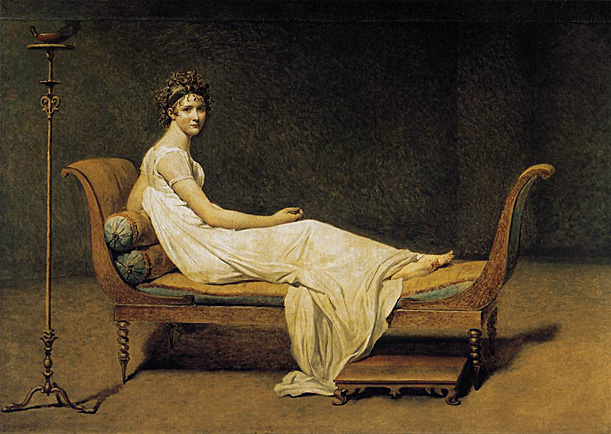Historical background to Les Dieux ont Soif
At the end of the 18th Century:
- The monarchy was decadent and distrusted.
- The nobility was privileged and hated.
- The church was unpopular with large sections of the population.
The people of France were still suffering the abuses of feudal times.
During the 18th century the failings of the French state were attacked
- By a group of writers called the Encyclopaedists, eg Montesquieu.
- By the great satirist, Voltaire.
- By the idealistic theorist, Rousseau.
The King did attempt to introduce reforms - but conservative elements in the country blocked them. One of the foremost in opposition to reform was his Austrian born queen, .Marie Antoinette.
In the Spring of 1789, France was almost bankrupt.
On the 5th May 1789, Louis XVI summoned the States General at Versailles.
Under the old regime the status of the population was classified into three “estates”, vey unequal in power and in number. The first two were the clergy and the nobility. Le tiers état was the mass of the people, rich and poor.
When the States general convened, the third estate demanded that the other two estates should join with them to form one assembly. For this unified gathering, they adopted the title of the National Assembly and began work on a new constitution.
(Among those elected to the third estate was Robespierre. Mirabeau described him as a "man who believed everything he said").
Mirabeau demanded that the King's troops should be withdrawn from Paris.
The King refused.
The people formed the National Guard. The popular unrest grew.
On the14th July 1789- The fortress of the Bastille in central Paris, then a prison, was stormed and taken by the mob with bloody vengeance against the defenders.
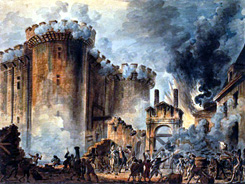
This picture shows the moment when the Marquis de Launay, the governor of the Bastille surrendered and was arrested. The mob dragged him to the Town Hall and there began to debate what horrific form his death would take. He begged to be killed humanely. They stabbed him repeatedly and then sawed off his head and cut his body into pieces, to be carried away in triumph.
National Guards were formed throughout France, to maintain some semblance of order..
Across France the property of the nobility was attacked.
The Assembly abolished all feudal privileges.
By the end of August 1789 - The declaration of the Rights of Man was adopted and France had officially become a constitutional monarchy
In September 1789 - Paris was hit by a severe shortage of bread and the public mood became ugly. The King taken by the mob from Versailles to Paris. They were installed under a relatively relaxed house arrest in the Tuileries Palace.
In Dec. 1789: The first "assignats" of the Revolution were issued. The property of the Church having been confiscated, promissory notes were issued on the security of these possessions. These served as currency and were issued in increasing numbers in later years. Many forged "assignats," printed in France and abroad, got into circulation. However, these assignats saved the economy of the Revolution.
In April 1790:
Robespierre became president of the Jacobin Club.
(Robespierre was a disciple of Rousseau and had an active interest in literature and the arts. His thinking owed much to his studies in Ancient History).
On 21st May 1790- The people set up Revolutionary Sections in Paris to secure their hold on power. Eventually these Sections were put under the control of a revolutionary committee, which took on ever increasing powers in ensuring that the laws and regulations that they introduced were obeyed.
They were later an arm of the Comité du Salut Public - but progressively became independent of all control.
The enthusiasm of the majority, however, did not survive the over-frequent meetingsand those that remained were the zealots..
The Sections were frequently given confiscated church property to use as their headquarters. This they defaced and decorated with their own emblems.
On 14th July 1790 - La Fête de la Federation (Page 76). Talleyrand surrounded by 300 priests and 14,000 provincial delegates (les Fédérés, celebrated mass in front of Louis XIV, who swore on oath to the constitution.
The ceremony seemed to promise harmony.
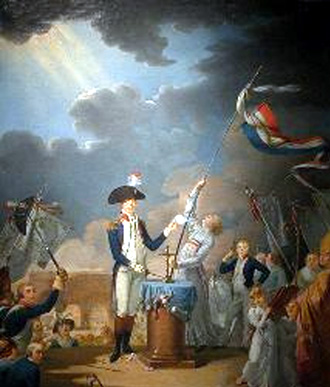
Above le marquis de Lafayetteswears the oath on behalf of the nobility at the La Fête de la Federation La Fayette, who had been a hero of the victory of the American settlers in the American War of Independence, was commander of the National Guard and later of all military in Paris. He gave the order for them to open fire on the demonstrators in the Champ-de-Mars (See below). He attempted to protect the king and escaped from France in August 1792 to avoid the retribution of the revolutionaries
On 21st June 1791: The apparent harmony was destroyed when the King escaped from Paris, hoping to reach the refuge of a royalist stronghold on the north east frontier of France.
He was recaptured and the royal famuily was back in detention in Paris within a week..
Robespierre demanded the king's trial.
On 17th July 1791-
A crowd of demonstrators gathered on the Champ de Mars demanding the abdication of the King.
They were dispersed by the Garde Nationale with 50 deaths. See page 104.
The Jacobin Club split. The moderates formed the Feuillantes Club - however Robespierre still had a huge popular following.
In Sept. 1791: The Assembly dissolved itself and a new constitution was agreed on 14th September 1791
Oct. 1791: The New Assembly was composed of: two opposing parties.
The Girondins were the moderates. They were also known as the Brissotins, as Brissot was their leader
The Montagnards were the extremists and they were divided into two groupings:
- The "Jacobins" led by Robespierre.
- The "Cordeliers" led by Danton and Desmoulins.
Robespierre did not join the new Assembly. Having given up the post of Public Prosecutor at the Paris Criminal Tribunal, he exerted his influence by speeches at the Jacobin club - over a hundred speeches.
In these speeches he:-
- Attacked Brissot, who was the most prominent Girondin..
- Denounced the secret intrigues of the Court and Royalists.
- Denounced the unpreparedness of the army.
- Demanded that aristocratic army officers should be dismissed.
Marie Antoinette hoped that her homeland would help her against the revolutionaries. However, the Imperial court of Austria was more urgently concerned to make the maximum gains at France's expense while the country was in chaos.
20th April 1792 - Angered by Austrian provocations, France declared war on Austria. The French royal family with its Austrian queen became even more unpopular. The mob was angry and looked to Robespierre for leadership in venting their anger.
On the 20th June 1792 - A mob broke int the Tuileries Palace and demanded that the king wear the tricolor to show his loyalty.
On 31st July 1792 - The legislative assembly declared that the Louis XVI was no longer king
As Robespierre had foreseen, the French armies were defeated.
Robespierre, however, was unwilling to call for a popular rising. He advised the fédérés - the provincial volunteers to act legally.
However-
On Aug. 10th 1792 - Mob insurrection broke out. The Tuileries Palace was stormed. The Swiss guard was slaughtered. The Monarchy was overthrown. De Lafayette fled France a week later.

At the forefront of the popular action were Marat and the Cordeliers.
The Paris Commune was now in effective control of the government of the country.
From Sept 1792 onwards-
The war against the enemies of the revolution was pursued with more vigour.
The revolutionaries sent forces to subdue those areas of France hostile to the revolution.
Priests resisting the Revolution’s new regulations for the Church were persecuted.
In September 1792 - Mob violence increased in intensity. During the September Massacres 1,200 priests, prostitutes, royalists and aristocrats were executed, having been declared to be a danger to the state, even though they were already held in prison. The Cordeliers and Marat were at the forefront of these massacres
.
The Girondins condemned these outrages - but they were finally outvoted in the Assembly.
On 20th September 1792 - The reorganised French army under General Doumouriez won a crucial victory over the Prussians at Valmy, in Northern France
On 21st September 1792 - The New Assembly, formed with the title of the National Convention, declared France a republic.
Robespierre, previously an advocate of constitutional monarchy, became a republican. In his campaign for election to the National Convention, Robespierre justified the September massacres.
He got mass support and was elected to the position of First Member of the National Assembly.
Immediately the Girondins - the majority party, began to attack him, accusing him of establishing his personal dictatorship.
On the 6th November 1792- the French army under Doumouriez defeated the Austrians at Jemappes and within a month conquered all Austrian territories in the Low Countries. But now France faced a new coalition of Spain, Portugal, Austria, England and Holland.
In December 1792 -Robespierre made 11 speeches demanding action against Louis. He was put on trial and was found guilty by the Convention andcondemned to death. Louis was not guillotined until the following month on January 21st 1793
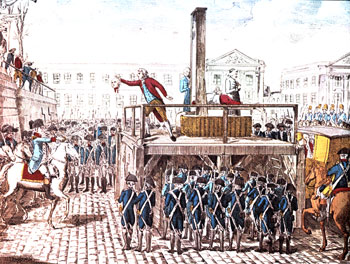
Under pressure from enemy armies and from the high level of anger and fear in the streets, the Convention set up "le Tribunal Révolutionnaire" to punish without appeal all counterrevolutionaries (Page 113) & (Page 52) This tribunal replaced the "Tribunal Criminel."
At first it observed regular legal procedure.
In the Convention the clash between Girondins or Brissotins and Montagnards, led by Robespierre, became increasingly bitter. Mutual accusations and recriminations had been brought to a head by the defection of General Dumouriez to the Austrians.(5th April 1793)
6th April 1793 It is at this point in history that Anatole France commences his novel.
Public discontent is heightened by the very dire situation in which the country finds itself. The Republic felt itself in mortal danger: - (Page 41).
- There was a bitter split in the Convention between Girondins and Montagnards/ Jacobins. The latter demanded strong central direction in the government of France and the Girondins demanded a Federalist structure.
- There were uprisings against the Revolution in the provinces
- Where some people reacted against the execution of the King.
- Where the polcy disagreements between Girondins and Montagnards sparked off incidents of bloody conflict.
- The threat from abroad was very dire. The French armies were now in retreat in the face of the combined assault of the armies of the coalition.
- The people were suffering. Food was scarce and prices high.
24th April 1793 - The Girondins were successful in bringing the man they regarded as the arch-extremist for trial before the tribunal. This man was Marat the journalist.
He made a passionate and violent speech to the gallery and was found not guilty by a unanimous verdict. He was freed among demonstrations of popular rejoicing and returned to the Convention.
A sick man he did not attend the Assembly again and was murdered in his bath by Charlotte Corday on the 13th July 1793. The painting is by David
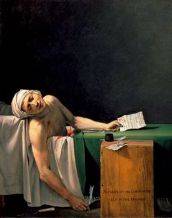
Robespierre's tactic against the Girondin majority which he faced in the Convention had been to appeal directly to the masses.
26th May 1793 - Robespierre invited the people to force their way into the Convention in revolt against the corrupt members.
31st May 1793.- Robespierre supported a motion indicting the leaders of the Gironde and the accomplices of Dumouriez.
As a result, 2nd June 1793.29 Girondins were indicted by the Convention. The armed revolutionary Sections of Paris, loyal to Robespierre, took to the streets.
24th June 1793.A New Constitution was introduced, with some articles written by Robespierre. With the downfall of the Girondins, the Jacobins were now in control.Their aim was centralised government - a united nation – “Une volonté une” -
They exerted dictatorial power through the Comite de salut public.
The Convention was weak and the Jacobins had the support of the masses.
Until July 1793, Danton was the leading member but when on the 27th July 1793- Robespierre became a member of the Comité de Salut Public he asserted himself as the new leader of the Revolution.
Below Maximilien de Robespierre, (1758 - 1794), architect of the Terror.
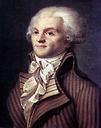
In August 1793 - He increased the power of the masses, when he created a second revolutionary Section. In Sept. 1793- two more Sections were added.
Robespierre also tightened his grip on the Jacobin club.
By ruthless action he suppressed all opposition from whatever direction.
Aug/Sep 1793 - He arrested extremist factions further to the left of him - the “enragés.”
4th Sept 1793 - He moved against the extremist Hébertistes, the popular movement which followed in the footsteps of Marat.
After the execution of the king a campaign had grown demanding the same fate for his queen.At Robespierre’s insistence Marie Antoinette was tried and disgraceful, mendacious accusations were made against her. She was executed on 14th October 1793.
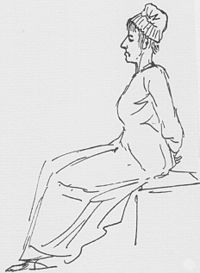
This sketch by the artist David shows Marie Antoinette resolutely keeping her poise as she is transported for beheading. Her last words were words of apology to the executioner for accidentally standing on his foot.
31st Oct 1793 - Robespierre then brought to trial his Girondin rivals from the Convention. They were duly convicted and executed. After the downfall of the Girondins, many more were accused of offences against the revolution and cases were dealt with more summarily in the tribunal.
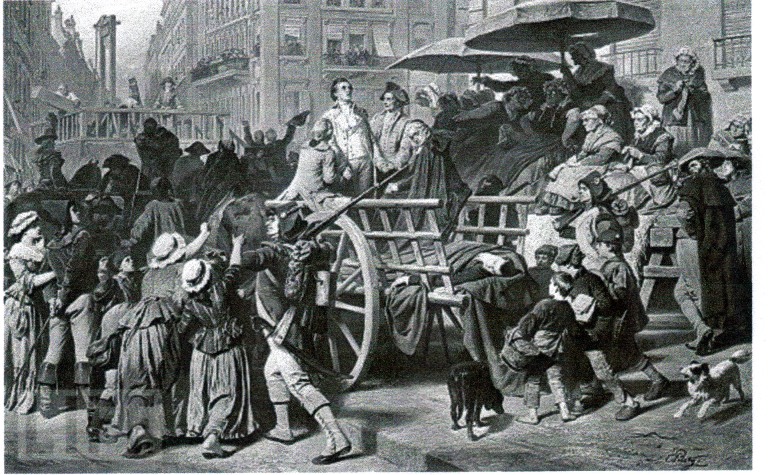
The execution of the Girondins
In Dec 1793 - Robespierre justified the terror by claiming that it enabled him to make total war on the enemies of France. He decided to intensify the terror even further..
In the following months the number of death sentences constantly multiplied:-
Deaths were as follows:-
Sept. 1793 - 110
Oct. 1793 - 180
Nov. 1793 - 500
Dec. 1793 - 3,380
Jan. 1794 - 3,500
Feb. 1794 - 800
March 1794 - 600
April 1794 - 1,100
May/ June 1794- 1,300
At the beginning of 1794, 5,000 people were imprisoned in Paris alone. The ordinary prisons could not hold them all. However, Robespierre was still a lawyer and did not favour indiscriminate indictments. He recalled from the provinces Tallien (See Page 205) and others whose atrocities were disgusting the people.
The ruthlessness of his government was rewarded with some success. Now the French armies were more successful with victories against the Coalition forces. - The counter-revolutionaries of La Vendée were crushed.
March 1794 - Nevertheless, the economic situation in France became even worse. The Hébertistes took advantage of this in an attempt to overthrow the Comité. They failed and 18 Hébertistes were guillotined on 24th March 1794.
The “Indulgents”, Danton and Desmoulins, recommended a different policy from Robespierre. They favoured negotiating peace with the European countries and a lessening of the terror. 5th April 1794 -Danton and Desmoulins, the boyhood friend of Robespierre, were executed.
4th June 1794 - Robespierre was elected President of the Convention by the massive majority of 216 votes out of 220.He was thus the absolute power.
8th June 1794- As he was a deist like Rousseau, Robespierre affirmed the existence of God and the immortality of the soul.
He inaugurated a new cult at the "Fête de l’Etre Suprême". Thus he offended the Catholics, the atheists, and those among his own ranks, who resented him playing the role of a prophet.
"La Fête de l’Etre Suprême".- In the Champ-de-Mars an artificial mountain was built. Anatole France mistakenly says this was in the Tuileries. The main ceremony was indeed in the Tuileries where a huge ampitheatre of greenery had been created for Robespierre's ceremony.
An assassination attempt by Henri Admiral failed.
There was alleged to be a conspiracy for revolt in the prisons. These wild unsubstantiated fears led to a further heightening of tension and resulted in the beginning of the period of High Terror.10th June 1794
Robespierre brought in a law shortening legal proceedings in order to speed up the work of the courts. This further dictatorial measure alarmed further those who feared that they could be his next victims and they secretly plotted against him.
The common people from whom his support had come previously were suffering great hardship and began to withdraw their support from him.
Robespierre tired and suffering from ill health stayed away from the Convention at a time when decisive action was called for against the growing movement of dissent
23rd July 1794 - Robespierre finally made a delayed appearance at the Comité de Salut Public
This he followed up with an address to the Convention - 26th July 1794-. At first his speech was greeted with loud applause as he attacked his opponents in the name of unity. However when he was asked to name the people, against whom he would be taking action, he declined. This struck fear in the hearts of those present. They formed the impression that he was asking for sweeping dictatorial powers, meaning that no-one of them could be sure to be safe from his arbitrary decisions.
Once Robespierre had left the Convention, the assembly revoked his decree.
That night, Robespierre made the same speech to the Jacobin club and was received with enthusiasm by an audience that had nothing to fear. In spite of their urgings, he refused to take immediate action against the Convention, Robespierre was confident that he would be able to bend the Convention to his will the following day.
However Robespierre had made a misjudgement. On that day, - 27th July 1794-the Convention refused to allow him to speak and decreed his arrest along with his associates.
When Robespierre was taken to the Luxembourg prison, the warden refused to take him into custody and he was freed to go to the Hôtel de Ville, where the Paris revolutionary Sections, his traditional supporters, had assembled to defend his cause.
They waited for Robespierre to give the word for violent action but he hesitated. The Convention had declared Robespierre an outlaw and so he and all who supported him faced immediate execution. As the rain began to fall, Robespierre's supporters left their positions t the Town Hall. Then other revolutionary Sections whose allegiances were to the Convention marched on the Hôtel de Ville to capture him.
Overwhelmed by this reaction, Robespierre recognised the inevitability of the guillotine. He attempted suicide and severely wounded himself by a shot through the jaw.
Doctors patched him up well enough to be executed the same day 28th July 1794 - on the Place de la Revolution - the Place de la Concorde, where the guillotine had been brought back, to allow the maximum number of people to enjoy his decapitation.
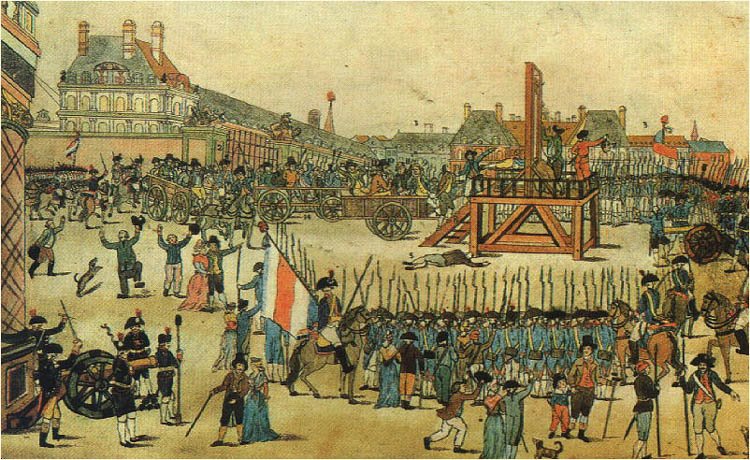
After this political coup, the Convention regained its power against the Comité de Salut Public and the Paris Commune.
In Paris the gilded youth (the Jeunesse Dorée) staged anti- Jacobin demonstrations.
The extremes of fashion of the gilded youth
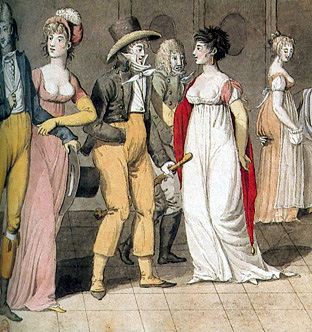
This was not the end of the Terror, however. The experience of the Terror had taught that those in power needed to annihilate opposing forces capable of becoming the next wave that would give them their turn on the guillotine.
Massacres of the Jacobins in Paris and the Provinces followed. The “White Terror” was as bloody as the previous “Red Terror”. In July 1794, at the period of the downfall of Robespierre, there were 935 executions in Paris alone.
The Revolutionary Tribunal, responsible for so much bloodshed, was abolished on 31st May 1795 and one of the last victims was Fouquier-Tinville - who had been public prosecutor at the Tribunal (Page 113).
A personal epilogue
Anatole France associates Gamelin with the revolutionary painter David. The latter was also arrested to face the guillotine with his idol Robespierre. However, in his case, he was saved by the pleas of his ex-wife, who had previously divorced him on account of his extremism.
In prison, perhaps understandably, David had been converted to the cause of civil reconciliation which he had expressed in his painting of the Sabine women intervening between warring parties, intended as a declaration of love to his wife. Below is a detail of this painting.
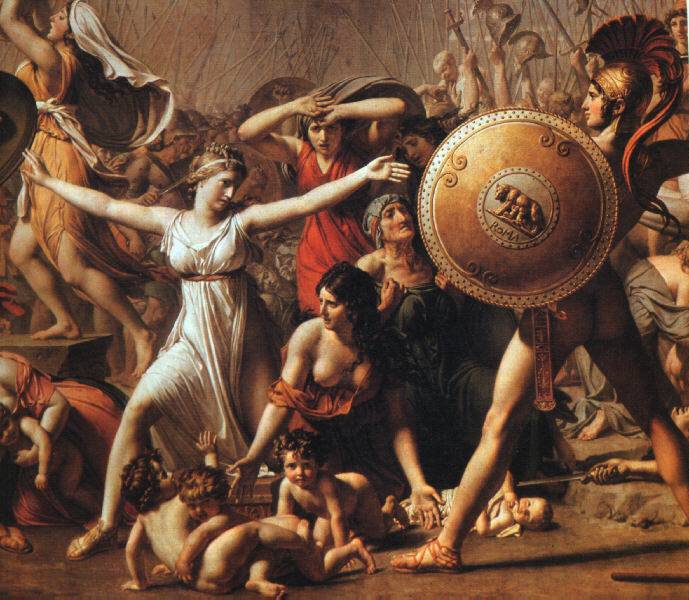
David became official painter to Napoleon producing world famous masterpieces, such as Napoleon crossing the Alps
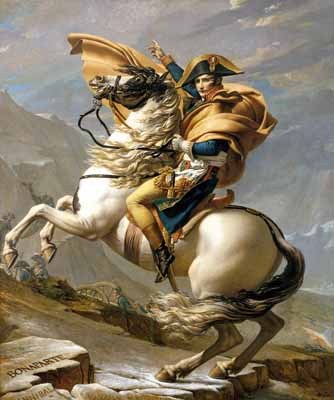
In the human warmth of other work, such as his painting of Mme de Récamier he gives us the reassurance that human love and beauty can sometimes survive after the grotesque insanity of ideological demagoguery.
